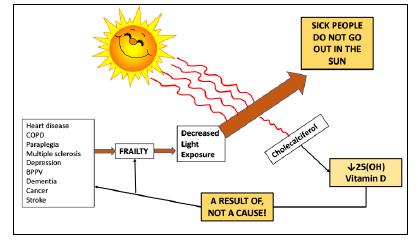
“Light equals Vitamin D”
~Alfred Fabion Hess
Over the last decade Vitamin D has become the magic elixir that is considered to help or prevent large numbers of health problems of older persons. Besides its effects on bone, vitamin D has been considered to be integral in the cause of immune dysfunction, falls, muscle weakness, cancer, cardiovascular disease, cognitive dysfunction, lung disease, stroke, paraplegia, benign paroxysmal positional vertigo; multiple sclerosis and depression (1-14). Frailty is a major cause of poor outcomes in older individuals (15-22) and has been associated with low levels of 25 (OH) Vitamin D (23-26). These claims are based predominantly on epidemiological studies. 25(OH) vitamin D is formed in the skin from the effect of ultraviolet light i.e., SUNLIGHT. All the diseases purported to be associated with Vitamin D deficiency are also associated with a decreased likelihood of the person going outdoors and thus being exposed to sunlight! (Figure 1). Similarly, while 25(OH) Vitamin D decreases with aging (27), aging is associated with a decreased exposure to sunlight.
Osteomalacia (rickets in children) is the one clear condition due to vitamin D deficiency. These children get weak, painful, deformed long bones due to impaired mineralization of bone. In adults with limited exposure to sunlight and a diet poor in vitamin D, osteomalacia can present with bone pain and muscle weakness along with low calcium and phosphate and elevated alkaline phosphate and parathormone. In adults, this occurs in persons with limited sun exposure and low intake of fish, meat and eggs. An example is adults with cancer and total parenteral nutrition without adequate vitamin D supplementation.
A major role of vitamin D is to enhance the absorption of calcium from the gastrointestinal tract. Low calcium absorption leads to failure to adequately suppress PTH. Elevated PTH causes calcium to be released from the bone. This results in osteoporosis. Utilizing PTH measurement the Institute of Medicine found that normal 25(OH) vitamin D levels should be between 20–25 ng/ml in Caucasian individuals (28).
Vitamin D, like most hormones, is bound to a carrier hormone (vitamin D binding protein – DBP) and it is the free hormone level that is predominantly available to cells (29). Like testosterone, a proportion of vitamin D is also bound to albumin. There are 3 major genetic variants of DBP. The GC*IF allele has a higher frequency is sub-Saharan Africans whereas GC*IS and GC*2 alleles have a higher frequency in pale skin individuals (30). These findings suggest that to measure vitamin D deficiency, a measurement of bioavailable vitamin D (free and albumin bound) is essential. If this is not available, a combination of PTH levels, alkaline phosphatase and calcium levels should be utilized to determine vitamin D deficiency.
Powe et al (31) reported that African Americans have significantly lower 25(OH) vitamin D levels compared to white Americans. They also had lower levels of VDP. In both groups, bioavailable vitamin D was more predictive of PTH concentrations, than total 25(OH) vitamin D levels.
McKee et al (32) found that in African-Americans while a 25(OH) D level of >20ng/ml (>50 nmol/L) were predictive of normal PTH levels, total 25(OH)D levels of <8ng/ml (<20nmol/L) was the cut-off for low bone mineral density. Merchant et al (33) examining a multi-ethnic group in Singapore found that over 50% of Malays and Indians would be considered vitamin D deficient when based on normal levels of 25(OH) D for Caucasians. Only 18.2% of Chinese were deficient. Chinese had the lowest DBP levels with Indians the highest. At present it is clear that there are major problems for the assays measuring 25(OH) vitamin D DBPs and free or bioavailable vitamin D (34,35).
Even when we focus on bone mineral density, hip fractures and falls, a major meta-analysis found that vitamin D supplementation was ineffective (36). Others have suggested that positive effects only occurred in those with the lowest levels of vitamin D (37,38).
So, what is the prudent clinician to conclude from the literature on vitamin D? Firstly, it is clear that the beneficial effects of vitamin D have been greatly oversold. Secondly, measurements of 25(OH) vitamin D are problematic and need to be adjusted for both ethnicity and bioavailability. Thirdly, in persons with low levels of 25(OH) vitamin D (<20ng/ml; 50nmol/L) replacement with low doses of vitamin D (800 to 1000 IU/daily) may be appropriate. There is no evidence for higher doses and a suggestion they may do harm (39). Fourthly, in persons who are ill, malnourished and have very limited sunlight exposure vitamin D replacement might be reasonable, but the supportive data is lacking. Fifthly, new interventional studies on vitamin D replacement concentrating on persons who are deficient are urgently needed. Finally, in an era of precision medicine (40,41) it is essential that attempts are made to determine which individuals will benefit from vitamin D replacement.
This editorial is deliberately provocative and hopefully will stimulate health professionals to re-evaluate the proposition that vitamin D is an emperor who is truly nude or more likely just not very well dressed!
Se J nutr Health aging on PUBMED for references
J Nutr Health Aging. 2019;23(4):316-317. doi: 10.1007/s12603-019-1178-x.
Dr. John Morley
Professor at Saint Louis University
No comments:
Post a Comment